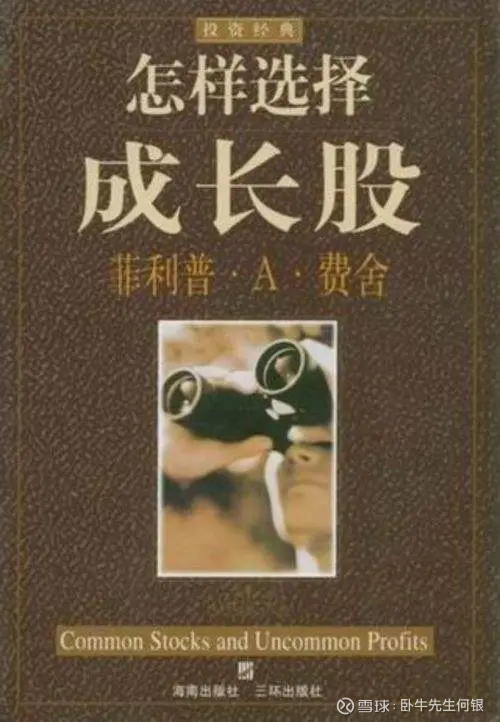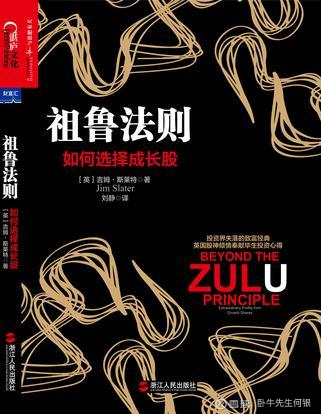I have been investing in stocks for nearly 16 years. During these years, I have read more than 800 investment books from various growth schools, value schools, trend schools, event-driven schools and financial behavior schools at home and abroad. All strategies are involved, and based on my years of practical experience, I have a set of investment systems of my own. Although I understand everything, it is indeed not very precise, but the comprehensive ability may be more comprehensive. During this process, I found that domestic and foreign stock market investment books are mixed, good and bad. If you read them one by one, it will waste a lot of time and energy. Based on my years of practical experience, I will share with you the classification and summary of the books I think are worth reading. To help new stock investors who are not very experienced to progress, today I will share the classic books at home and abroad on growth stock investment.
1. “How to choose growth stocks”
Author: Philip Fisher

Buffett also said that he has read this book many times, and Buffett’s later investment system is also clearly integrated into the genes of Fisher-Price growth stocks. The book is divided into three parts: the top part, common stocks and uncommon profits; the second part, conservative investors sit back and relax; the third part, the formation of investment philosophy. The key content of the whole book is in the front part, which describes in detail how to choose growth stocks. The author puts forward 15 principles, of which the most famous is the use of “chat”, and also explains in detail when to buy according to your needs. , when to sell and when not to sell, the hustle and bustle of dividends, the five don’ts for investors, the other five don’t for investors, etc.
2. “Peter Lynch’s Successful Investing”

Written by Peter Lynch, written by John Rotherchild
Peter Lynch is a very good fund manager. The fund he managed has returned 26 times in 13 years, with an annualized rate of return of 29%. The annualized rate of return is far higher than Buffett. Unfortunately, he retired early. Peter Lynch is my favorite investment guru. He likes to invest in unpopular high-quality stocks, because high-quality stocks in unpopular times have both valuation, cost performance and growth potential, and he is good at mining unpopular desert flowers. His method is also very down-to-earth, easy to understand, and relatively easy for retail investors to learn. He teaches ordinary investors how to use their own advantages to defeat professional institutions.
In the book, Peter Lynch analyzes stocks into 6 types one by one, summarizes 13 characteristics of how to select 10 times stocks, and reminds to avoid 6 types of dangerous stocks. And systematically explain how to build a portfolio and how to hold a reasonable number of stocks. The best time to buy and sell stocks. How to obtain information from securities companies, company annual reports and other channels. How to use the price-earnings ratio, book value per share, etc. to conduct investment analysis, find real data worthy of reference in financial statements, and find big bull stocks in stocks that seem to have no chance. At the same time, it analyzes common misunderstandings of investment psychology to help investors avoid investment traps.
3. The Zulu Rule
Author: Jim Slater

Jim Slater is an entrepreneur, a former fishing king, who has mined gold, built real estate, and went bankrupt. He first proposed the PEG valuation method that I commonly use.
Slater’s “Zulu Law” mainly emphasizes that retail investors, who have always been weak in the investment market, must learn from the Zulu people and focus their firepower on their chosen niche and specialized fields, so as to exert their advantages, and then defeat the large corporations and earn excess compensation. The stock selection method is to emphasize the strategy of “focusing” and stressing “small stocks”, looking for small and medium-sized companies with rising profits, and stocks with higher than average price-earnings ratios and growth forecasts. stock selection criteria ─ ─ Zulu rule. The book describes the valuable stock selection criteria for active growth stocks, turnaround stocks, business cycle stocks, backdoor listed stocks and leading stocks. He also discusses many other important factors related to investing, such as bookkeeping, portfolio management, foreign stock markets, and investor-salesperson relationships.
4. “How to Find 100x Return Stocks”
Author: Christopher Meyer

The first two books may have been read by many old investors, but many people do not know the last two books, especially the last one. This book is not well-known, but the author’s summary of the super growth bull stocks is still worth reading and learning.
The author studied 365 stocks of 100 times from 1962 to 2014, and found that such stocks are not as rare as some investors imagined, and found that such stocks have some obvious characteristics, there are certain rules to follow, and carefully summed up A set of principles helps readers find these stocks in the current market.
Conclusion: These are the classic and practical investment books for growth stocks, while the investment method for growth stocks has a relatively long period of actual verification. I hope it will help everyone. Next time, I will summarize the classic must-read books for value investing.
$Shanghai Snowbo Woo Niu No.1(P000770)$
There are 28 discussions on this topic in Snowball, click to view.
Snowball is an investor’s social network, and smart investors are here.
Click to download Snowball mobile client http://xueqiu.com/xz ]]>
This article is reproduced from: http://xueqiu.com/3241529995/233147047
This site is for inclusion only, and the copyright belongs to the original author.